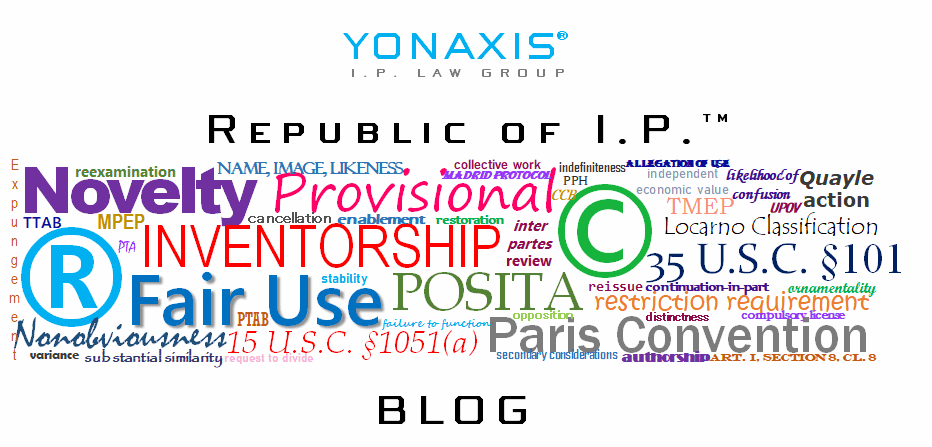U.S. Patent No. 9,895,404 B1 issued on February 20, 2018, for “Cannabidiol Extraction Plant and Processes,” to Paul T. Baskis. This is a utility patent, specified in 35 U.S.C. §101, because it describes a new process for extracting CBD from the cannabis plant.[1] There is certainly a method, or process or algorithm, being described in …
Category: patent
CannabIP: U.S. Patent No. 9,888,703 B2
U.S. Patent No. 9,888,703 was issued on February 13, 2018, for “Method for Making Coffee Products Containing Cannabis Ingredients,” to Christopher Bhairam. It is one of the latest issued patents directed to subject matter involving cannabis. The disclosure is directed to methods of making coffee containing doses of tetrahydrocannabinol (THC) extracted into the coffee pod. …
CannabIP: U.S. Patent No. PP27,475 P2
U.S. Patent No. PP27,475 was issued on December 20, 2016, for “Cannabis Plant Named ‘Ecuadorian sativa’.” It is the first plant patent issued by the U.S. Patent and Trademark Office for a new strain of a cannabis plant. Botanical details as specified in the specification note that it is taxonomically in the genus Cannabis, and …
Fed Circuit Watch: Google Upends Patent Troll’s Claims as Obvious
This is the third recent precedential case issued by the Court of Appeals for the Federal Circuit in January that disposed of patent claims as obvious. This case is noteworthy because the losing party is an alleged patent troll, and the winning party is none other than Google. The case, Arendi S.a.r.l. v. Google, LLC,[1] …
CannabIP: U.S. Patent No. D798,739
U.S. Patent No. D798,739 was issued for “Cannabis Storing Container with Individual Tear Off Lids,” a design patent, on October 3, 2017. It was issued to Brian K. Reaux. The invention is actually the ornamental features of an adhesive lid covering the container, and not the container itself. Patents are issued for: subject matter which …
Fed Circuit Watch: Motion-Tracking Patent Beats Obviousness Finding
This is the second of a trio of recent Federal Circuit precedential cases that have dealt with the law of obviousness that we will review for this blog. Here, in Elbit Systems of America, LLC v. Thales Visionix, Inc.,[1] the Court of Appeals for the Federal Circuit held that claims directed to a motion-tracking patent …
Fed Circuit Watch: Still Another §101 Decision Signals Sea Change
On February 14, 2018, the Court of Appeals for the Federal Circuit handed down Aatrix Software, Inc. v. Green Shades Software, Inc.,[1] which signals a possible sea change in the §101 patent-eligibility analysis and potentially give patent holders some ammunition to fight invalidation of their patents. This opinion also tracks the rather complex federal court …
Fed Circuit Watch: Who Let the Cat Out? Faulty USPTO Obviousness Analysis
On February 9, 2018, the Court of Appeals for the Federal Circuit handed down Polaris Indus., Inc. v. Arctic Cat, Inc.,[1] where a Fed Circuit panel criticized the invalidation of all 38 claims of Polaris’ patent as obvious under 35 U.S.C. §103 over different combinations of prior art based on the PTAB’s messy §103 analysis. …
No Tribal Sovereign Immunity in IPR
On February 23, 2018, the Patent Trial and Appeal Board of the U.S. Patent and Trademark Office issued a decision denying the St. Regis Mohawk Tribe’s various motions to terminate several inter partes review proceedings based on the theory of tribal sovereign immunity. The consolidated case was Mylan Pharmaceuticals Inc., et al. v. Saint Regis …
Fed Circuit Watch: Fed Circuit Lacks Jurisdiction to Review Antitrust Claim
On February 9, 2018, the Court of Appeals for the Federal Circuit issued a short order refusing jurisdiction over a Walker Process antitrust claim, and transferred the case, Xitronix Corp. v. KLA-Tencor Corp., to the Court of Appeals for the Fifth Circuit. As a preliminary note, a Walker Process claim is a federal claim under …
